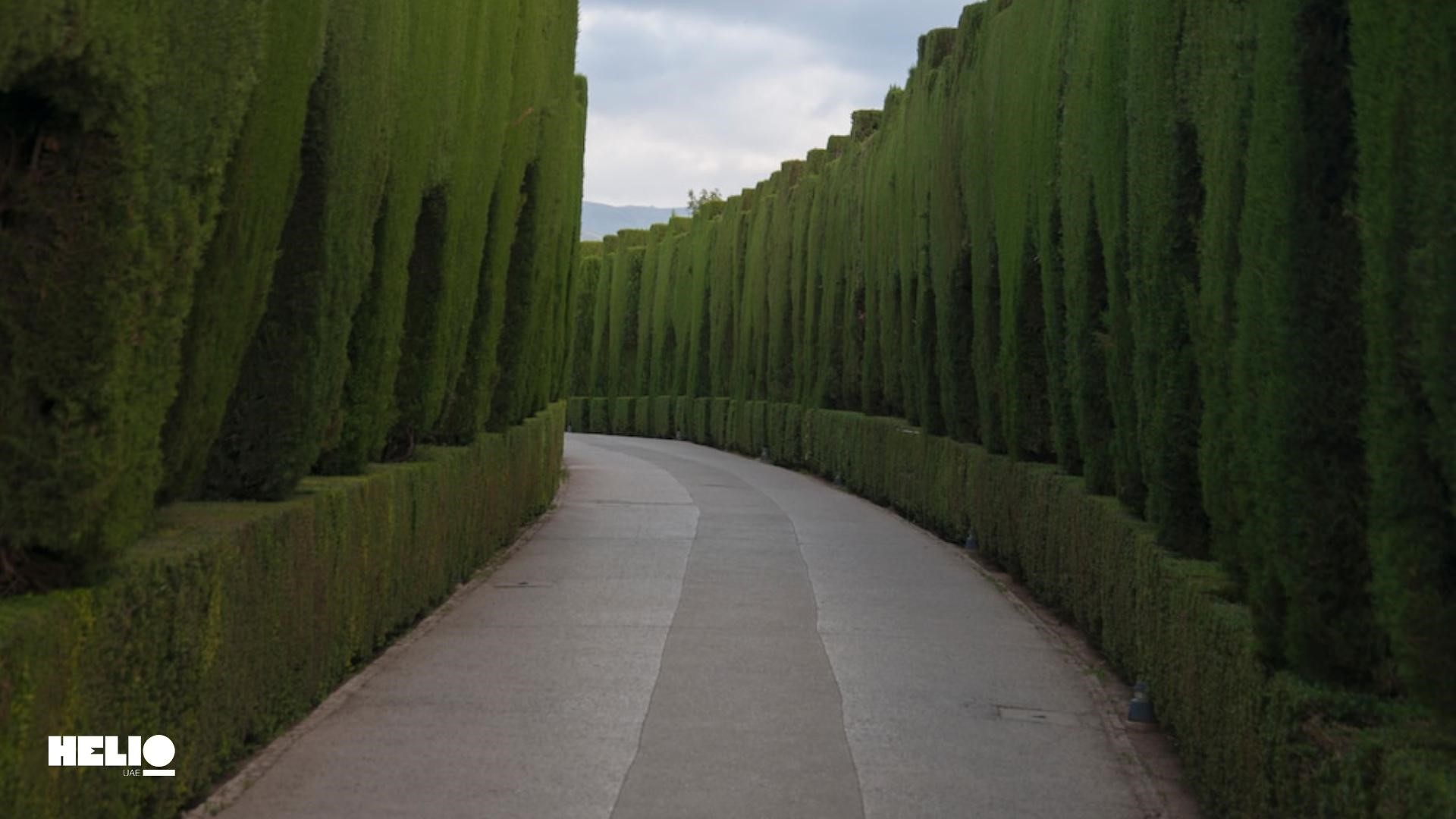Lately, the blend of natural beauty with architectural ingenuity has become more critical in the urban environment. This blog post from Helio Archi will guide you through the fascinating world of landscape architecture, showcasing its importance, trends, and the skills needed to excel in this field. You’ll discover how landscape architecture shapes our cities, improves our quality of life, and promotes sustainability.
Whether you’re an architecture enthusiast, an environmental designer, an urban planner, or an architect in the UAE market, this comprehensive guide will provide valuable insights. Dive in and explore how you can contribute to creating beautiful and functional urban spaces.
Introduction to Landscape Architecture
Landscape architecture is the art and science of designing outdoor spaces harmonizing with the environment. It involves planning, designing, and managing landscapes, from small gardens to vast parks. This field requires a deep understanding of plant biology, soil science, and climate, as well as an aesthetic eye for creating visually pleasing and functional spaces.
The scope is broad, encompassing everything from aesthetic considerations to ecological sustainability. Landscape architects work on various projects, including urban parks, residential areas, commercial sites, and public spaces, always aiming to create environments that enhance the quality of life while preserving natural resources.
The relevance of landscape architecture cannot be overstated. It plays a vital role in enhancing the quality of life by creating functional, sustainable, and aesthetically pleasing environments. Whether it’s a public park, a rooftop garden, or a residential backyard, landscape architecture enriches our surroundings.
What is Landscape Architecture and Its Integration with Other Disciplines
Landscape architecture is a multidisciplinary field that integrates principles from architecture, engineering, horticulture, and environmental science. This collaboration ensures that landscapes are not only beautiful but also functional and sustainable. Landscape architects work on various projects, from urban parks and recreational areas to private gardens and corporate campuses.
By considering factors like soil health, water management, and native plant species, they create spaces that enhance both the environment and the quality of life for those who use them. Their work contributes to urban planning, heritage conservation, and creating green spaces that promote mental and physical well-being.
Importance of Landscape Design Architecture
As cities grow and expand, the need for well-designed outdoor spaces becomes increasingly crucial. Landscape architecture has numerous benefits, including improved air quality, noise reduction, and urban heat island mitigation.
Environmental Benefits
Landscape architecture offers numerous environmental benefits. For instance, green spaces serve as natural air purifiers by absorbing pollutants and releasing oxygen. Additionally, urban trees and plants help mitigate the urban heat island effect, reducing city temperatures and energy consumption.
Social and Mental Health Benefits
Green spaces significantly impact social interaction and mental well-being. Parks and gardens provide a serene environment for relaxation and exercise, fostering community bonds and reducing stress levels. Studies have shown that access to green spaces can improve mental health and well-being.
Economic Value and Sustainability
Investing in landscape architecture can enhance property values and attract tourism, contributing to economic growth. Sustainable landscape design also minimizes resource consumption and promotes biodiversity, ensuring long-term environmental health.
Current Trends in Landscape Architecture (2024)
The field of landscape architecture is continuously evolving, adapting to new technologies and societal needs. Some current trends in the industry include:
Emphasis on Sustainability and Eco-friendly Designs
There will be a heightened focus on sustainability in 2024. Eco-friendly designs that promote water conservation, native plantings, and renewable energy sources are becoming standard practices.
Technological Advancements
Technological advancements are revolutionizing landscape architecture. Building Information Modeling (BIM) and computational design tools allow for more precise and efficient planning. These technologies enable architects to visualize and modify designs in real time, enhancing creativity and accuracy.
Innovative Urban Solutions
Innovative solutions like pocket parks and green roofs are gaining popularity. These small, strategically placed green spaces provide urban dwellers with accessible nature, improving the urban environment’s overall quality.
Focus on Mental Health and Well-being
There is a growing recognition of landscape architecture’s role in mental health. Designs incorporating natural elements and promoting tranquility are in high demand, reflecting a societal shift towards well-being and mindfulness.
Types of Landscape Architecture Projects
Landscape architecture encompasses a diverse range of projects, each with its unique challenges and objectives. Some common types of landscape architecture projects include:
Urban Design and Public Parks
Urban design projects include public parks, plazas, and streetscapes. These spaces are designed to be functional, accessible, and aesthetically pleasing, enhancing urban life.
Private and Community Gardens
Private and community gardens offer a personal touch, providing residents with tranquil spaces to relax and connect with nature. These projects often emphasize sustainability and native plantings.
Living Roofs and Roof Gardens
Living roofs and roof gardens are innovative solutions for urban areas. They provide green spaces while maximizing the use of limited space, offering environmental benefits like insulation and stormwater management.
Historical Preservation and Restoration
Preserving and restoring historical landscapes is another crucial aspect of landscape architecture. These projects maintain cultural heritage while adapting spaces for modern use.
Role and Responsibilities of Landscape Architects
Landscape architects play a critical role in creating sustainable and functional outdoor spaces. Their responsibilities include:
Planning and Design
Landscape architects are responsible for planning and designing outdoor spaces. To create harmonious environments, they consider various factors, including aesthetics, functionality, and sustainability.
Site Surveying and Report Writing
Conducting site surveys and writing detailed reports are essential tasks. These activities ensure the design aligns with the site’s conditions and complies with regulations.
Client Interactions and Project Management
Client interaction is crucial for understanding needs and preferences. Landscape architects also manage projects from inception to completion, coordinating with other professionals and overseeing construction.
Collaboration with Other Professionals
Collaboration with architects, engineers, and horticulturists is essential. This interdisciplinary approach ensures that the design is holistic and integrates various aspects of landscape architecture.

Education and Skills Required for Landscape Architects
To become a landscape architect, one must have a combination of education and skills. A bachelor’s or master’s degree in landscape architecture is typically required, along with the following skills:
Formal Education Paths
A career in landscape architecture typically requires a bachelor’s or master’s degree. These programs provide foundational knowledge and practical skills in design, ecology, and project management.
Essential Skills
Essential skills include sensitivity to landscape quality, technical expertise, and effective project management. These skills enable landscape architects to create impactful and functional designs.
Importance of Interdisciplinary Knowledge
Interdisciplinary knowledge is vital for success. Understanding principles from related fields like architecture, engineering, and horticulture enhances a landscape architect’s ability to design comprehensive and sustainable landscapes.
Elements of Landscape Architecture
Landscape architecture is a multidisciplinary field that integrates various elements to create functional and aesthetically pleasing outdoor spaces. Some key aspects of landscape architecture include:
Fundamental Design Elements
Key design elements include color, line, form, texture, and scale. Together, they create visually appealing and cohesive landscapes.
Integration of Softscape and Hardscape Elements
A successful design integrates softscape (plants, trees) and hardscape (paths, walls, etc.) elements. This balance creates harmonious and functional outdoor spaces.
Use of Sustainable Materials
Sustainability is a crucial aspect of landscape architecture. Using sustainable materials like recycled materials or locally sourced products reduces environmental impact and promotes eco-friendliness.
Incorporation of Natural Systems
Landscape architects often incorporate natural systems into their designs. These include water management systems, erosion control measures, and biodiversity conservation techniques.
Conclusion
As technology advances, societal needs evolve, and sustainability becomes increasingly important, the landscape architecture industry must adapt to these changing trends. Understanding the various aspects of landscape architecture, from design principles to interdisciplinary collaborations, is crucial for creating functional and sustainable outdoor spaces that promote well-being and enhance our urban environments. So continue exploring this fascinating field, and consider how you can contribute to shaping a greener and more livable world through landscape architecture.
Are you ready to transform your outdoor area into a beautiful and functional space? Let Helio Archi bring your vision to life. Our experienced landscape architects are dedicated to designing sustainable, aesthetically pleasing environments tailored to your needs. Contact us today to start your journey towards a greener and more enjoyable outdoor space.





